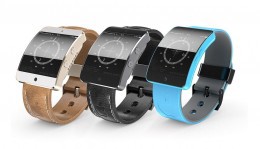Paying for the Things You Never Fathomed You’d Pay For

I was at lunch with a friend a few months ago when he looked down at his watch and said, “Oh I just got a message from [so-and-so] — I’ll need to dash off in 15 minutes.”
“You got a text message on your watch?” I asked, bewildered. “Can you respond on it?”
“No, I have to pull out my phone to respond — isn’t that silly?”
Having to handle two electronic devices at once to deal with a text message did seem silly to me, and I told him so.
“I know, I know,” he said. “But just wait until Apple comes out with their watch, you’ll be changing your tune soon enough.”
“Never!” I exclaimed.
“Never say never!” he retorted.
Maybe he had a point. Sometimes we end up buying things we never think we’d ever pay for and wonder where it all went wrong.
I had, after all, made this same claim about smartphones.
“It’s expensive, and it’s not a necessity!” I had reasoned. Generation after generation of iPhone lines came and went while I walked the Earth blissfully with my flip phone.
And then I walked into a Verizon store one day to get my very dumb phone fixed, and the salesperson said, “You know you have this upgrade on your account, right? You can get the new iPhone for free.”
I waffled. But didn’t I have to get a data plan? Wouldn’t this cost me more in the long run?
Here, try it.
I tried it, and I liked it.
“Okay, sure, I’ll take it.”
I held it in my hands and could feel myself transforming into the kind of person who is always checking his email; who doesn’t get hopelessly lost anymore thanks to the map function; who takes videos and photos of his friend’s cats to cherish later; who deposits paper checks via app; who saves articles to read on the subway; who mindlessly looks at his phone, swiping at buttons while waiting for dinner dates to show up for reservations.
I walked out of that store knowing I’d never go back to flip phones.
It happens. When I was a kid, my father, who only ever bought generic brands at the grocery store (“it’s the same thing, but cheaper!”), would occasionally slip some name brand stuff into the cart (“it’s on sale!” and then, later, “you know, this might be better” It wasn’t). It was all in the marketing.
That free iPhone upgrade was also marketing, even though I tried to pretend that it wasn’t.
Kevin Roose, in New York magazine, explains how the marketing will get us to buy this goofy-little smartwatch. Someone you know will buy it. Apple will make adjustments as it collects user data and will subsequently make very useful applications for it. You’ll see more people you know with it around their wrist. “Hmm, it is kind of cool,” you might think. “Maybe I should get it.” Roose:
This instinct, and the simple, primordial envy that produces it, is what’s made it possible for Apple to sell luxury devices to the masses even in a time of stagnant wages and widening inequality, inspiring millions of people to stretch their budgets in order to accommodate yet another device they can’t really afford. It’s what’s made my first thought, after dropping a $600 piece of metal and glass in the ocean by accident last year, not “Why did I buy a $600 piece of metal and glass that isn’t waterproof?” but “Where can I get another one, stat?”
Someday I’ll walk into a store, and someone will hand me a smartwatch.
“It’s free!”
Or maybe someone will give me her older model smartwatch.
I’ve always wondered what the big deal was about this, I’ll think.
Hook, line and sinker.
Support The Billfold
The Billfold continues to exist thanks to support from our readers. Help us continue to do our work by making a monthly pledge on Patreon or a one-time-only contribution through PayPal.
Comments